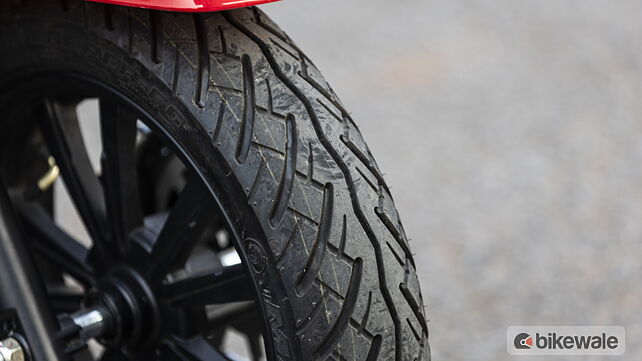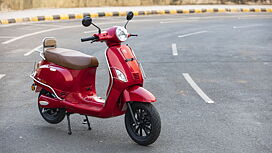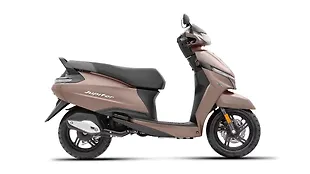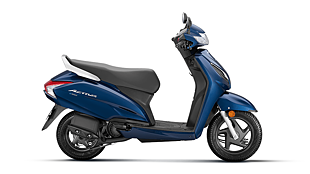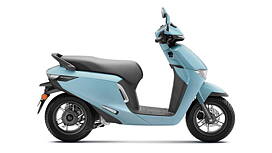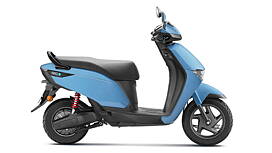Introduction

The fact that electric mobility is rapidly seeping into our lives can be verified by the number of EVs we have been reviewing. This is the third over a period of a month. So, the transition is in full swing and inevitable. As for the electric scooter you see in these pictures, it’s the Benling Aura.
Benling India is owned by China-based Dongguan Benling Vehicle Technology which exports to over 83 countries. Benling was introduced in India in 2019 and has managed to expand its reach to around 185 cities since then. The Aura is the brand’s only high-speed electric scooter out of the four models it sells in India. The scooter looks promising, considering its on-paper specifications, claimed battery range and top speed, removable battery, and neo-retro design. However, that’s the case with many EVs, most of which fail to deliver an experience as pleasant as they are advertised to. What kind is the Aura then? Let’s find out.
The Visuals

As is obvious, the Aura looks nearly identical to Vespa’s VXL range. With a neo-retro design, it seamlessly blends in any flock of ICE scooters. The flowy body panels, round headlamp, flat beige-coloured seat, and pillion backrest make for a simple yet elegant-looking scooter. Although this will help Benling in garnering people’s attention and thereby better sales, we would have liked an original design.

As attractive as is the Aura visually, the overall quality of the product is almost equally admirable. The first thing that catches your attention is the plush paint finish and sturdy plastic panels. Even the fitment is decent with no component making weird noises or shifting from their designated place. I liked the quality and tactility of the switchgear too, except for the fact the crucial horn and start/stop buttons can’t be reached easily. Moreover, the cover and the hinges of the lockable glove box at the front felt too flimsy to withstand any sort of abuse.
The Package

The Aura is propelled by a 2.5kW BLDC (brushless DC) motor powered by a 2.88Kwh lithium-ion battery. The claimed top speed and battery range stand at 60kmph and 120km, respectively. There are three riding modes with varying top speeds which are denoted by numbers 1 (35kmph), 2 (48kmph), and 3 (60kmph). You get the 4th mode, too, which delivers quicker acceleration while maxing out at 60kmph.
The cockpit area is occupied by a large black LCD which doesn’t go well with the overall premium feel of the scooter. It displays the speed, battery level, riding mode, and distance covered. It could have included the remaining battery range for the users to plan their rides better; the charge level on its four-point battery indicator keeps fluctuating with the variation in the pace.

In terms of storage space, the battery occupies most of the under-seat area, with little space to store your belongings. At best, it can gobble up a full-size backpack, one that isn’t overly stuffed. As for the front storage provision, it has enough room to accommodate a smartphone while plugged into the USB charging port, or a small water bottle. Thanks to the centre hump, even the footboard doesn’t offer much area.
Other features include regenerative braking and an anti-theft security system. The latter blows a loud alarm if someone tries to move or unlock (with the key) the scooter after you’ve locked it through the remote controller provided.
The Ride

On the go, the Aura feels comfortable as it offers a neutral riding position. The handlebar is easy to reach and the footboard isn’t too high to make you sit in an awkward squatting position, as is the case with some electric scooters. What’s an issue though is the width of the seat that makes it a bit difficult to step your feet on the ground, even if you’re sitting ahead on the seat. This wasn’t a major issue for me, thanks to my 5’11’’ stature, but could be a bane for some. Plus, the cushioning of the seat could do with a better density as you start feeling the hard surface underneath within half an hour of riding.

As for the performance, the Aura has the typical EV-like consistent pull until its top speed, but not as lively as the Ather 450X. However, quick sprints from zero to 60kmph in the fourth (fastest) mode are quite fun. Even the whining motor sound isn’t loud enough to be an annoyance.
Similar to many other electric two-wheelers, the on/off throttle transition is a little abrupt, especially in the 2nd, 3rd, and 4th modes in which riding the scooter in stop and go traffic turns out to be a jerky affair. The throttle responds with a sudden acceleration while moving from a standstill. However, in the slowest mode, this issue isn’t as severe. I also noticed that even if I held on the throttle constant anywhere beyond 40kmph, the power delivery kept on fluctuating, exuding a rocking sensation.

As for the ride quality, the suspension setup has been tuned on the firmer side as you can feel even the smallest of undulations. The front, in particular, feels extremely stiff as it keeps bobbing while going over rough patches, thereby constantly shaking your arms. The rear feels a little more forgiving than the front but the firmness can still be sensed. The lack of seat foam density only adds to the discomfort here.

The handling, though not very sharp, is agile enough to make your way through traffic swiftly, which is also courtesy of its low 95kg kerb weight. The brakes, meanwhile, are reasonably efficient with great progression and decent bite. The front is equipped with a disc that does a great job of shedding speed while the rear drum, too, acts progressively enough to avoid locking the wheel in most conditions.

Now, the 120km battery range might sound impressive but one can extract that figure only on riding it in the slowest (1st) mode. I rode it with a mix of all modes and got a range of about 80-85km. It also goes down to about 60-65km if you keep it in the 4th mode constantly and accelerate it to the fullest at every opportunity.
For charging the scooter, you have the option to directly plug it into a conventional 5A socket. Otherwise, the battery is removable for you to take it indoors and charge. A complete charge takes about five to six hours.

One problem I see with the removable battery is its weight. It’s so heavy that pulling it out of the scooter and walking with it even for a few minutes is physically demanding. It makes me nervous to imagine myself doing this routinely Having said that, this isn’t unique to the Benling as batteries of electric scooters are generally heavy. I remember using the Okinawa Praise Pro back in 2019 which comprised a removable battery equally heavy.
Should You Buy It?

The Benling Aura displayed some admirable traits along with a few niggles. The good bits include its elegant neo-retro styling that would attract every member of a family from different age groups and not just youngsters. Even the build quality is sturdy enough to match an ICE scooter. And with a real-world range of 80-90km and a top speed of 60kmph, it’s a practical and useable proposition for commuting.

But when we take scooters into consideration, we expect them to offer a generous amount of storage space which the Aura lacks substantially. It also falls short in terms of comfort by offering a firm ride quality and an awkwardly wide seat. Even the instrument cluster should display more information, at least the remaining battery range.

What makes the Benling Aura worth considering though is its ex-showroom price tag of Rs 82,975. Most of the electric scooters with similar battery and motor specifications are priced higher than the Aura. Plus, Benling’s dealership network is quite robust with around 185 shops across India in the metro, tier-2, and tier-3 cities. Sure, the Aura has rough edges but some of the major issues associated with EVs related to performance and build quality aren’t as severe in this case.
Photos by Kapil Angane
Gallery
1/42
Benling Aura Front Wheel
Double Tap to Zoom










